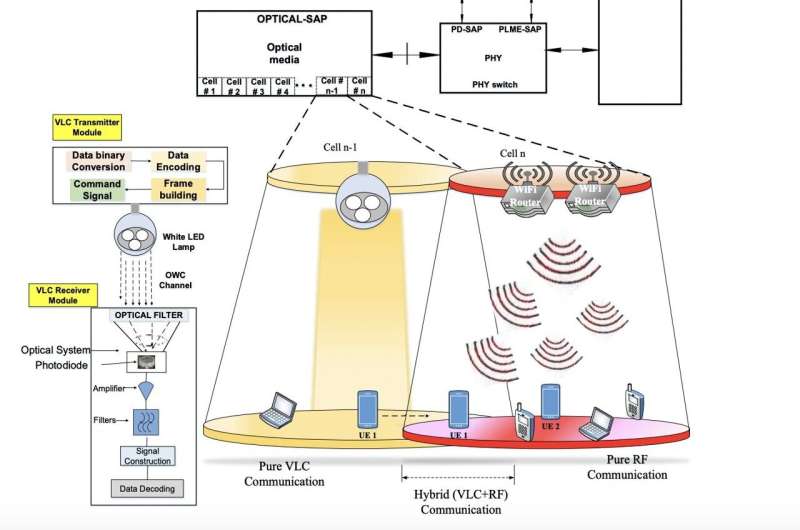
August 13, 2024 by Ingrid Fadelli , Tech Xplore
Collected at: https://techxplore.com/news/2024-08-hybrid-rf-vlc-power-consumption.html
Wireless internet supports the daily activities of countless people worldwide, ranging from their professional communications to internet browsing and the streaming of movies or TV series. This spiking demand for wireless internet access goes hand in hand with greater power consumption, which in turn contributes to carbon emissions worldwide.
Future wireless networks should be able to support the high computational demands of many modern applications and internet services, while limiting power consumption. Some researchers have thus been developing energy efficient techniques supporting communication between devices and the sharing of media or other information online.
One of these solutions is known as visible light communication (VLC). This is a method to realize efficient wireless communication using visible light to transmit data, relying on light-emitting diodes (LEDs) or other artificial light sources.
Researchers at Central University (CU), IIDM and CU J&K in India recently developed a new hybrid approach that merges VLC with RF communication. Their proposed hybrid solution, introduced in a paper published in IEEE Transactions on Green Communications and Networking, could enable reliable communication in indoor environments with a high data transmission rate, while consuming less energy.
“There is a need to decrease the carbon footprint in the atmosphere and also make the network safe and reliable,” Haneet Kour, Rakesh Kumar Jha and Sanjeev Jain wrote in their paper. “We propose a hybrid system of RF (Radio Frequency) and VLC (Visible Light Communication) for indoor communication that can provide communication along with illumination with less power consumption. The hybrid network is viable as it utilizes power with respect to the user demand and maintains the required Quality of Service (QoS) and Quality of Experience (QoE) for a particular application in use.”
The wireless communication system devised by this team of researchers has two key components: a transmitter and a receiver module. These two modules are physically separate from each other, yet they are connected via a VLC channel.
As suggested by its name, the transmitter transmits binary data stored inside it in the form of LED-produced light. The team also propose the use of modulation schemes that help to maintain a continuous stream of data, while also keeping the average power consumed at a constant value throughout communication.
The receiver, on the other hand, is comprised of a photo-sensitive device, which could be a photodiode or a camera. This device can extract the information contained in the light emitted by the receiver if the transmitting device is in its line of sight.
Kour, Kha and their colleagues carried out an initial evaluation of their proposed indoor wireless communication system using various simulation platforms. Their findings suggest that the system could enable stable communication between devices in the same indoor environment, with significant energy savings.
“A comparative analysis for RF communication, Hybrid (RF+ VLC) and pure VLC is made and simulations are carried out using Python, Scilab and MathWorks tool,” Kour, Jha and Jain wrote in their paper.
“The proposal achieves high energy efficiency of about 37 low Specific Absorption Rate (SAR), lower incident and absorbed power density, complexity and temperature elevation in human body tissues exposed to the radiation. It also enhances the battery lifetime of the mobile device in use by increasing the lifetime by approximately 7 hours as validated from the obtained results.”
The recent study by this team of researchers contributes to ongoing efforts aimed at reducing power consumption and electromagnetic radiation by improving the energy-efficiency of wireless communications. The initial simulations they run highlight the promise of their approach, which could be further improved and tested in future studies.
More information: Haneet Kour et al, Green and Safe 6G Wireless Networks: A Hybrid Approach, IEEE Transactions on Green Communications and Networking (2024). DOI: 10.1109/TGCN.2024.3396162. On arXiv: arxiv.org/pdf/2407.17512
Journal information: arXiv

Leave a Reply